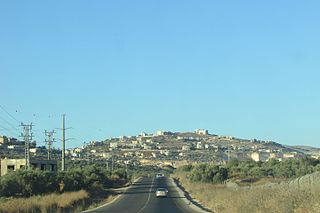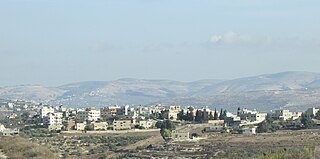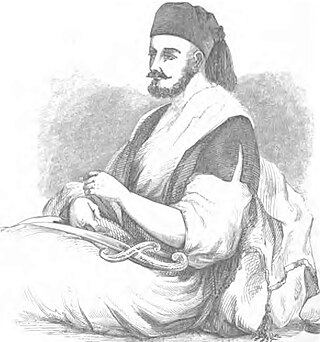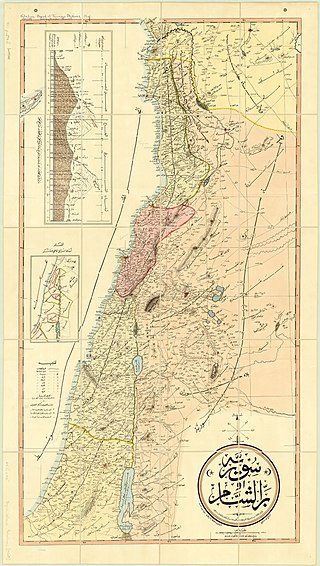Related Research Articles

Jamma'in is a Palestinian town in the Nablus Governorate of the State of Palestine, in the northern West Bank, located 16 kilometers (9.9 mi) southwest of Nablus, 6 kilometers (3.7 mi) northwest of Salfit and 40 kilometers (25 mi) north of Ramallah. According to the Palestinian Central Bureau of Statistics, the town had a population of 6,227 in 2007.
Deir al-Ghusun is a Palestinian town in the Tulkarm Governorate, located eight kilometers northeast of the city of Tulkarm in the northern West Bank, Palestine. The town is near the Green Line. The town had a population of 8,242 in 2007. Its altitude is 200 meters.

Sanur is a Palestinian village located 26 kilometres (16 mi) southwest of Jenin, in the Jenin Governorate of the State of Palestine. According to the Palestinian Central Bureau of Statistics, Sanur had a population of 4,067 in 2007. During the late Ottoman era, Sanur served as a fortified village of the Jarrar family and played a key role in limiting the centralized power of the Ottoman sultanate, the Ottoman governors of Damascus and Acre and the Ottoman-aligned Tuqan family of Nablus from exerting direct authority over the rural highlands of Jabal Nablus.
Beit Wazan is a Palestinian village in the Nablus Governorate of the State of Palestine, in the northern West Bank, located 4.5 kilometers west of Nablus. According to the Palestinian Central Bureau of Statistics (PCBS), the village had a population of 1,120 inhabitants in mid-year 2006.

Sarra is a Palestinian town in the Nablus Governorate in northern West Bank, located 11 kilometers southwest of Nablus. According to the Palestinian Central Bureau of Statistics (PCBS), the town had a population of 2,892 inhabitants in mid-year 2006.

Zeita is a Palestinian town in the Tulkarm Governorate in the western West Bank, located 11 kilometers North-east of Tulkarm. According to the Palestinian Central Bureau of Statistics, Zeita had a population of 2,852 inhabitants in 2007. 21.5% of the population of Zeita were refugees in 1997. The healthcare facilities for Zeita are designated as MOH level 2.

The Nablus Sanjak was an administrative area that existed throughout Ottoman rule in the Levant (1517–1917). It was administratively part of the Damascus Eyalet until 1864 when it became part of Syria Vilayet and then the Beirut Vilayet in 1888.
Jarrar is a large Palestinian family that served as rural landlords and tax-collectors (mutasallims) in the Jenin area during Ottoman rule in Palestine. During this era, they were the most powerful of the rural families in Palestine's central highlands.
The Peasants' Revolt was a rebellion against Egyptian conscription and taxation policies in Palestine. While rebel ranks consisted mostly of the local peasantry, urban notables and Bedouin tribes also formed an integral part of the revolt, which was a collective reaction to Egypt's gradual elimination of the unofficial rights and privileges previously enjoyed by the various classes of society in the Levant under Ottoman rule.
The Tuqan clan is a prominent Palestinian and Jordanian political and business family. During the Ottoman era, they dominated the political and socio-economic spheres in Nablus and extended their influence to al-Salt. During that era, they were the only household that came close to establishing centralized rule over Jabal Nablus. Over the course of the 18th and 19th centuries the Tuqan family held the title of mutasallim of Nablus longer than any other local family.

Aqil Agha al-Hasi was the strongman of northern Palestine in the mid-19th century, during Ottoman rule. He was originally a commander of Arab irregular soldiers, known as the Hawwara tribe, in the service of the Ottoman governors of Acre. His influence in the Galilee grew as he strengthened his alliances with the powerful Beni Sakhr and Anizzah tribes of Transjordan, and recruited unemployed Bedouin irregulars from Egypt into his own band of irregulars, who thenceforth became known as the Hanadi tribe. He was known by his men and Western travelers to be courageous, cunning and charismatic, all qualities that contributed to his rise as the de facto ruler of the Galilee.

The 1834 siege of Jerusalem took place during the Peasants' revolt in Palestine, which erupted following the entry of Egyptian general Ibrahim Pasha into Ottoman Syria and his subsequent military conscription demand upon the Arab villagers of the region. The siege was engaged by local Arab peasant rebels upon an Egyptian garrison of about 2,000 soldiers, beginning from May 21 until the arrival of Ibrahim Pasha's main force on June 7. The crushing defeat of rebel reinforcements took place on June 9, led by Ibrahim Pasha.
The 1834 Hebron massacre occurred in early August 1834, when the forces of Ibrahim Pasha launched an assault against Hebron to crush the last pocket of significant resistance in Palestine during the Peasants' revolt in Palestine. After heavy street battles, the Egyptian Army defeated the rebels of Hebron, and afterward subjected Hebron's inhabitants to violence following the fall of the city. About 500 civilians and rebels were killed, while the Egyptian Army experienced 260 casualties.
Throne villages were villages in the central mountain areas of Palestine that served as seats of political and military power for the local leaders (sheikhs) of rural subdistricts primarily during the latter half of Ottoman rule.
Sulayman Pasha al-Adil was the Ottoman governor of Sidon Eyalet between 1805 and 1819, ruling from his Acre headquarters. He also simultaneously served as governor of Damascus Eyalet between 1810 and 1812. He was a mamluk of his predecessor, Jazzar Pasha. His rule was associated with decentralization, a reduction of Acre's military, and limits to his predecessors' cotton monopoly. Moreover, he oversaw a policy of non-interference with his deputy governors, such as Muhammad Abu-Nabbut and Mustafa Agha Barbar, and diplomacy with the autonomous sheikhs of the various Levantine regions where he held authority, including Emir Bashir Shihab II and Musa Bey Tuqan. He exercised control over his domain largely through depending on the loyalty of his deputies, who also had been mamluks of Jazzar. In effect, Sulayman Pasha presided over the world's last functioning mamluk system.
Abdullah Pasha ibn Ali was the Ottoman governor (wali) of Sidon Eyalet between May 1820 and May 1832, with a nine-month interruption in 1822–23. Like his predecessors Jazzar Pasha and Sulayman Pasha, Abdullah Pasha ruled from the port city of Acre. During his reign, all of Palestine and the Syrian coastline came under his jurisdiction. Among his major military victories was his survival of an imperial-backed siege of Acre in 1822 instigated by the Farhi family in retaliation for Abdullah's execution of his mentor Haim Farhi, the suppression of revolts in Mount Lebanon and Jerusalem in 1824 and 1826, respectively, and the 1831 capture of the Sanur fortress.
Husayn Abd al-Hadi was a sheikh of the Jabal Nablus region, head of the Abd al-Hadi clan of Arraba and a deputy of Ibrahim Pasha in Palestine. During Ibrahim Pasha's rule, he also served as the governor of Sidon Eyalet.

Siege of Al-Karak was a 17-day siege imposed by Ibrahim Pasha of Egypt on the Transjordanian town of Al-Karak in 1834. The Pasha laid the siege on the town in pursuit of Qasim al-Ahmad, the leader of the Peasants' revolt in Palestine, who had fled from Nablus to take shelter in Al-Karak.

The Syrian Peasant Revolt was an armed uprising of Levantine peasant classes against the rule of Ibrahim Pasha of Egypt in 1834–35. The revolt took place in areas of Ottoman Syria, at the time, ruled by the semi-independent ruler of Egypt, who conquered the region from loyal Ottoman forces in 1831.
References
- 1 2 3 Doumani, 1995, p. 46
- ↑ Kramer, 2011, p. 67
- 1 2 Baer, 1982, p. 291
- 1 2 3 Beinin, 2001, p. 33
- ↑ Doumani, 1995, p. 48
- 1 2 3 4 Macalister and Masterman, 1906, p. 36
- ↑ Doumani, 1995, p. 208
- ↑ Doumani, 1995, p. 302
- ↑ Doumani, 1995, pp. 208 –209.
- 1 2 Macalister and Masterman, 1906, p. 37
- ↑ Doumani, 1995, p. 37
- ↑ Rood, pp. 132-133.
- ↑ Robinson and Smith, 1841, vol 3, pp. 135 136
- 1 2 3 Macalister and Masterman, 1906, p. 39
- ↑ Rustum, 1938, p. 75
- ↑ Rood, p. 134.
- ↑ Rood, Judith (2006), "The Time the Peasants Entered Jerusalem: The Revolt Against Ibrahim Pasha in the Islamic Court Sources" (PDF), Jerusalem Quarterly, Institute of Palestine Studies, p. 39, archived from the original (PDF) on 2015-09-24, retrieved 2015-11-05